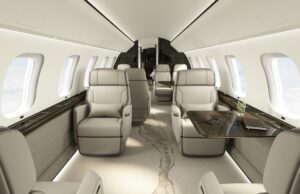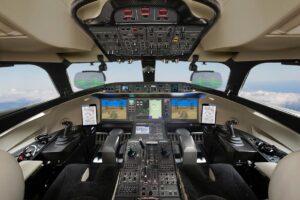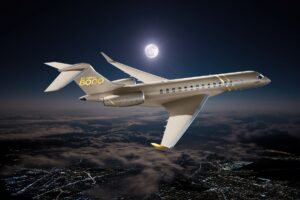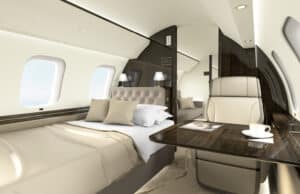Aerospace
Bombardier Introduces Global 8000 Aircraft, the Flagship for a New Era in Business Aviation
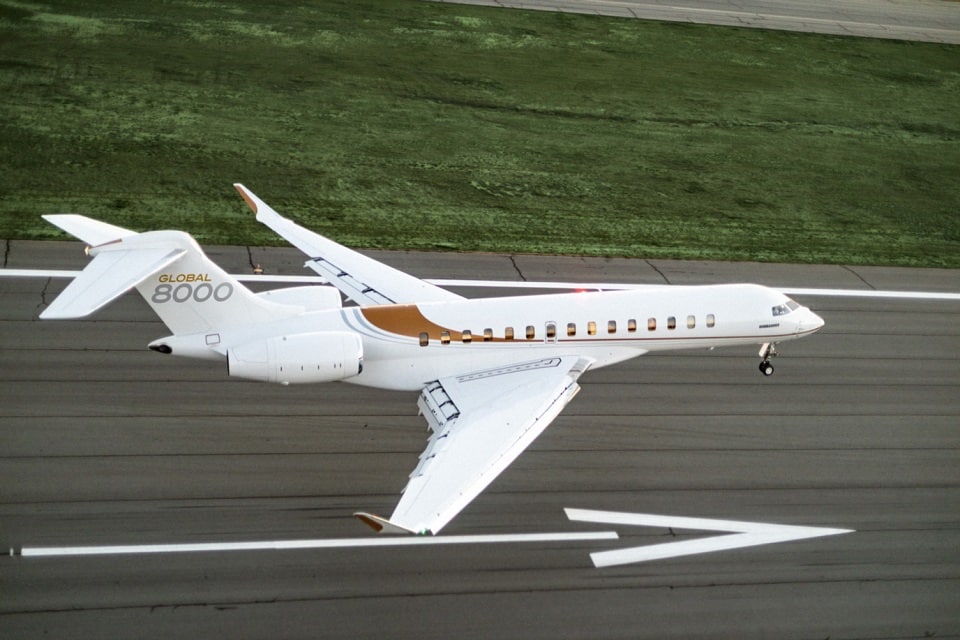
- Bombardier’s new Global 8000 aircraft stands alone as the world’s fastest and longest-range purpose-built business jet, innovatively crafted with the industry’s smoothest ride, healthiest cabin, and lowest cabin altitude
- With its innovative Smooth Flex Wing and super-efficient Passport engines, the Global 8000 jet features a top speed of Mach 0.94 – the fastest business jet in the skies
- The Global 8000 aircraft will be the only true four-zone cabin business jet to have a range of 8,000 nautical miles, unlocking even more city pairs than ever before
- Current Global 7500 operators will be able to retrofit their aircraft to experience the incredible performance enhancements on the Global 8000 aircraft
Bombardier today unveiled the newest member of its industry-leading business jet portfolio with the introduction of the Global 8000 aircraft, the world’s fastest and longest-range purpose-built business jet, innovatively crafted with the industry’s healthiest cabin for safety, comfort and performance beyond compromise.
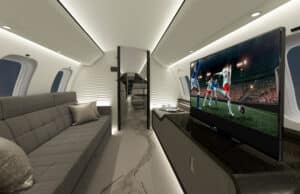
Lavish Cabin
With an industry-leading range of 8,000 nautical miles and an unbeatable top speed of Mach 0.94, the Global 8000 aircraft is the ultimate all-in-one business aircraft, offering customers a unique blend of outstanding performance married with the smoothest ride and an uncompromising passenger experience – the absolute leader in the long-range class.
“Today, Bombardier solidifies once more its position as the leader in business aviation with the newest member of the industry-leading Global family,” said Éric Martel, Bombardier’s President and Chief Executive Officer. “
The Global 8000 aircraft leverages the outstanding attributes of the Global 7500 aircraft, providing our customers with a flagship aircraft of a new era. We remain unmatched, which for an innovation-focused team like us, is great.”
Some of the impressive performance capabilities of the new Global 8000 aircraft were witnessed as early as May 2021, following a demonstration flight with a Global 7500 flight test vehicle.
The aircraft, accompanied by a NASA F/A-18 chase plane, repeatably achieved speeds in excess of Mach 1.015, a key step in enabling a maximum Mach operating speed (MMO) of M0.94 and becoming the fastest business jet in the world and the fastest in civil aviation since the Concorde.
During the demonstration flight, the aircraft also became the first Transport Category airplane to fly supersonic with sustainable aviation fuel (SAF). The discerning Global 8000 business jet also features the healthiest cabin in the industry, with the lowest cabin altitude in its class of 2,900 feet when flying at 41,000 ft. It is also equipped with Bombardier’s Pũr Air and advanced HEPA filter technology for the cleanest cabin air and the fastest fresh air replacement.
The Global 8000 aircraft is the only true four-zone cabin business jet to have a range of 8,000 nautical miles – and it more than delivers even when it comes to comfort. With its spacious four personalized suites ergonomically designed to maximize space and freedom of movement.
The Global 8000 aircraft also incorporates the revolutionary features introduced on the Global 7500 aircraft that dramatically improve passenger comfort, including the Soleil circadian lighting system to help combat jet lag. Coupled with the innovative Nuage seat with the first-ever zero gravity position, passengers will arrive at their destinations revitalized and refreshed.
An exemplary commitment to detail is assured on the new Global 8000 aircraft, including an available Principal Suite with a full-size bed and a stand-up shower in the En-suite. Revolutionary cabin entertainment control and connectivity, the intuitive nice Touch CMS and OLED touch dial, Bombardier’s l’Opéra directional audio sound system and available 4K monitor, also ensures passengers will receive an unrivalled cabin experience.
In the cockpit, the Global 8000 aircraft features the renowned Bombardier Vision flight deck with its next generation fly-by-wire technology and blend of cutting-edge avionics with exceptional ergonomics and aesthetics for remarkable comfort and control.
Performance-wise, the new Global 8000 aircraft can efficiently transport customers to a wide variety of destinations both faster and farther than ever before. And with its exceptional class-leading range and short-field performance, even more exclusive city pairs are now achievable, including Dubai-Houston, Singapore-Los Angeles, London-Perth and many others.
Expected to enter service in 2025, the Global 8000 aircraft development is ongoing, and the program is progressing to plan. And for current Global 7500 operators, the incredible performance enhancements on the Global 8000 will be retrofittable when the aircraft enters into service in 2025.
The introduction of the new Global 8000 aircraft has been a carefully planned investment that further strengthens Bombardier’s impressive portfolio of industry-defining business jets. Development to date has been included in previously disclosed investment figures. All further development costs will be included in Bombardier’s capex, which remains in line with its 2025 objectives.

Aerospace
Boeing Transfers Rocket Stage to NASA, Paving Way for Human Moon Mission

Boeing has achieved a significant milestone by providing NASA with the second core stage of the Space Launch System (SLS) rocket.
This crucial component, crafted at NASA’s Michoud Assembly Facility (MAF), is set to propel the Artemis II crew into lunar orbit, marking humanity’s return to deep space after a 50-year hiatus.
The monumental Boeing-built rocket stage, the largest element of the Artemis II mission, will embark on a journey aboard the Pegasus barge, traveling 900 miles to NASA’s Kennedy Space Center.
Comparison of two legendary aircraft B777x vs B747 aircraft:Click here
Upon arrival, it will be meticulously integrated with other essential Artemis II components, including the upper stage, solid rocket boosters, and NASA’s Orion spacecraft within the iconic Vehicle Assembly Building. This intricate integration process is a vital step toward the eagerly anticipated Artemis II launch, slated for 2025.
“Boeing-built products helped land humankind on the moon in 1969, and we’re proud to continue that legacy through the Artemis generation,” remarked Dave Dutcher, vice president and program manager for Boeing’s SLS program. “Together, with NASA and our industry partners and suppliers, we are building the world’s most capable rocket and paving the way to deep space through America’s rocket factory in New Orleans.”
NASA, Lockheed Martin Reveal X-59 Quiet Supersonic Aircraft:Click here
The delivery of Core Stage 2 marks a significant achievement in the evolution of the SLS rocket. Towering over 200 feet and powered by four RS-25 engines, this core stage, coupled with two solid-fueled booster rockets, will generate a staggering 8.8 million pounds of thrust. This immense power is crucial to launching Artemis II and future missions into the vast expanse of space.
The SLS rocket stands unparalleled in its capability to transport both crew and substantial cargo to the moon and beyond in a single launch. Its extraordinary capacity will facilitate the delivery of human-rated spacecraft, habitats, and scientific missions to destinations including the moon and Mars, ushering in a new era of space exploration.
-

 Travel1 week ago
Travel1 week agoAir India to Expand US Operations with Three New Routes After a Decade
-

 Travel2 weeks ago
Travel2 weeks agoWhy We Should Avoid These Stamps in a Passport
-

 Airlines1 month ago
Airlines1 month agoInvestigations Reveal Fake Chinese Titanium in Boeing and Airbus Jets
-

 Tech4 weeks ago
Tech4 weeks agoChina’s CATL Plans 1,800-Mile Electric Plane Launch by 2027
-

 Airport3 days ago
Airport3 days agoTop 10 Largest Airports in the World by Size
-

 Aerospace4 weeks ago
Aerospace4 weeks agoChina’s Fighter Jets Turn Wings into Autonomous Drones
-

 Airlines4 days ago
Airlines4 days agoAir India Rolls Out A350s for Delhi-New York JFK and Newark Routes
-

 Defence3 weeks ago
Defence3 weeks agoBoeing Enhances Chinook with New Engines and Block II Upgrades at $96 Million

